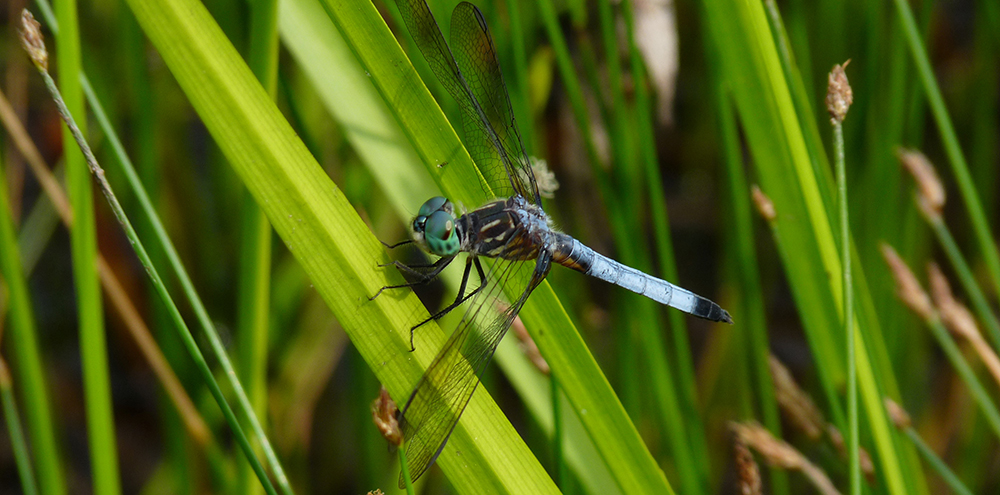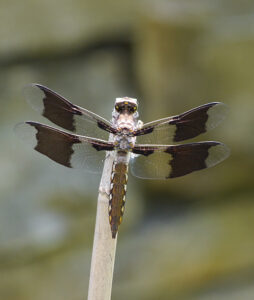For the past dozen years, from spring through fall, dragonfly researcher John McLeran has been hiking Highstead’s meadows and grounds on sunny days. He’s not just enjoying the peace of being in nature; he’s collecting data by counting dragonflies and damselflies. While walking the trails from the field to the pond, he has three spots where he stops to count dragonflies and damselflies. Part of the Odonata order, aquatic insects are older than dinosaurs and are considered indicators of water quality and environmental health.

“It gives me such pleasure. I’ve been going to Highstead, partly because it’s so beautiful,” the Redding resident says. Dragonflies fascinate him. “Their amazing flight patterns – they fly backwards, straight up, and can turn on a dime. NASA studies their wing patterns.”
While McLeran says his sample is too small to draw any scientific conclusions about dragonfly habitat on Highstead’s property, his 12 years of observational data show that some species of dragonflies consistently live at Highstead – the widow skimmer, common green darner, Eastern pondhawk, blue dasher, slaty skimmer, Eastern amberwing, and others. He spotted others only in 2014, never seen since – common spreadwing, calico pennant, lillypad forktail, swamp spreadwing, and dragonhunter.
He observed two other species earlier in his Highstead visits, Carolina saddlebags, and black saddlebags, but hasn’t seen the former since 2015 and the latter since 2018. On the other hand, he has spotted some species that are recent arrivals to Highstead – the great blue skimmer (2020, 2022,) skimming bluet (2021, 2022,) and a darner variety (2022) that he suspects is a harlequin.

There are at least 158 species of dragonflies and damselflies in Connecticut, he says. McLeran has observed 36 of those species at Highstead. People can observe about a third with their eyes or binoculars. Another third can be caught, captured, observed under a magnifying glass, and let go. The other third needs to be looked at under a microscope for identification. For the sake of the dragonflies, McLeran says he only counts the charismatic insects he can identify without capture. His long-term observations are recorded in the Connecticut Museum of Natural History database at UConn.
When he takes his dragonfly census, he visits Highstead for about two to three hours on a sunny day when the dragonflies are out hunting for food. Dragonflies like to bask in the sun in the morning to absorb heat, like turtles and snakes. He sees some dragonflies near the pond and others in the meadow. “My sample is so small; I might only find a dozen species. Of those, four or five will be dominant,” he says. “I might see 10 or 12 different individuals of the same species.” His census is part of an ongoing population study in partnership with Highstead Senior Ecologist Ed Faison.

While he doesn’t know why, there are several species he has started seeing again in recent years following a five- or six-year gap. But since the years of the gap were not uniform, it’s impossible to draw any conclusions, says the semi-retired McLeran, who works as a part-time land manager for the Redding Land Trust and Town of Redding. He recorded the common whitetail, Eastern forktail, and common baskettail in 2013 and didn’t see the whitetail and forktail until 2019 and the baskettail until 2018. But he saw both every year after that reappearance up to and including 2022.
Dragonflies spend 80% of their lifespan underwater, he says. It’s only when they emerge in the spring or summer that they fly around. Most dragonflies don’t migrate because it’s too cold for them to move, he says, but the green darner is one exception.
For those looking to spot dragonflies, “generally speaking, a pond is going to give you the best diversity, especially if you’re limited on time,” McLeran says. “Shallow, weedy ponds are popular dragonfly habitats.”